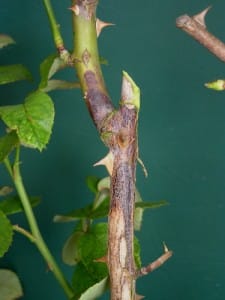Source(s): Randy Drinkard
Several fungi are capable of causing stem canker and dieback of roses.
Symptoms:
Cankers begin as spots ranging in color from yellow to purple, depending on the causal fungus. The developing cankers become sunken, forming wrinkled or cracked lesions that are tan to black. Canker margins are brown to reddish purple. Numerous small, black, wart-like specks embedded within the canker area are fruiting bodies of the causal fungus. Cankers often enlarge until the stem is girdled. Once the stem is girdled, the foliage above the canker wilts and dies. Cankers that form at the graft union usually result in plant death.
Disease Cycle:
The fungi causing stem canker and dieback usually survive the winter on diseased canes or plant debris. Spores of the causal fungi are usually spread by wind-blown rain or irrigation water. Rose canes are infected through wounds during periods of humid, wet weather. The disease may also be spread by fungus-contaminated pruning tools. Cankers often form on the stub of pruned canes, but they may also be seen around leaf or thorn scars, winter injury, or other damage on the canes. Stem canker and dieback are most damaging to weak, slow-growing roses.
Control:
When establishing or renovating rose beds, always plant canker-free roses and space the plants to allow for good air circulation. Promote good plant vigor and minimize canker damage by irrigating and by fertilizing according to soil test recommendations. Avoid any unnecessary damage when pruning or handling plants. Make pruning cuts just above the node, leaving a small stub to speed callus formation. Remove cankers by cutting 5 to 6 inches below the canker margin. After each cut, dip pruning tools in 70-percent alcohol or a dilution of 1 part household bleach and 4 parts water. This will prevent the further spread of the disease. Treat roses with Daconil, Immunox, Funginex or other recommended fungicides according to label instructions to provide protection from stem canker and dieback.
Resource(s):
Common Landscape Diseases In Georgia
Center Publication Number: 116
- Saddleback Caterpillars: Watch Out for that Sting - September 26, 2018
- Hanging Baskets - September 24, 2013
- Houseplant Help - September 24, 2013
